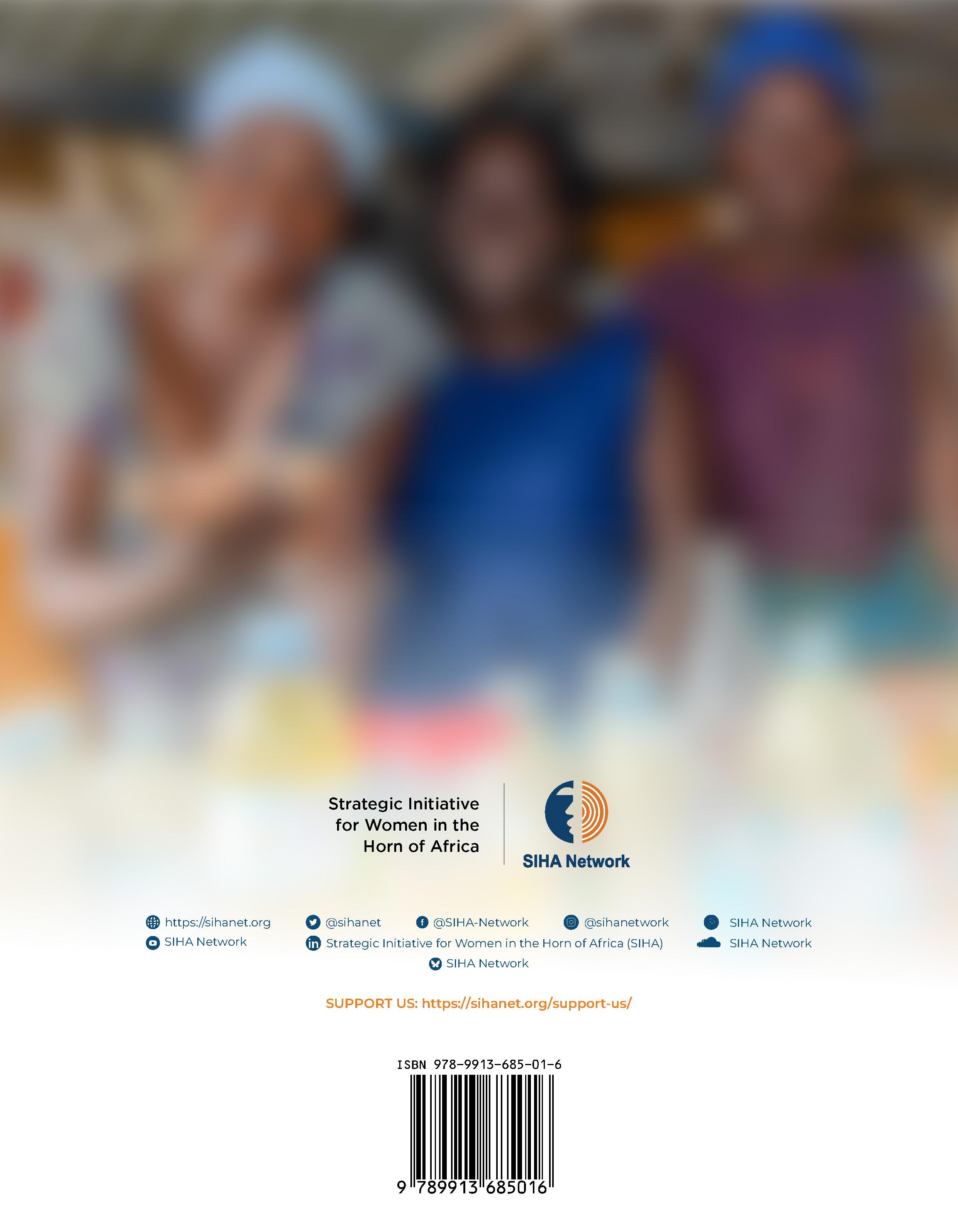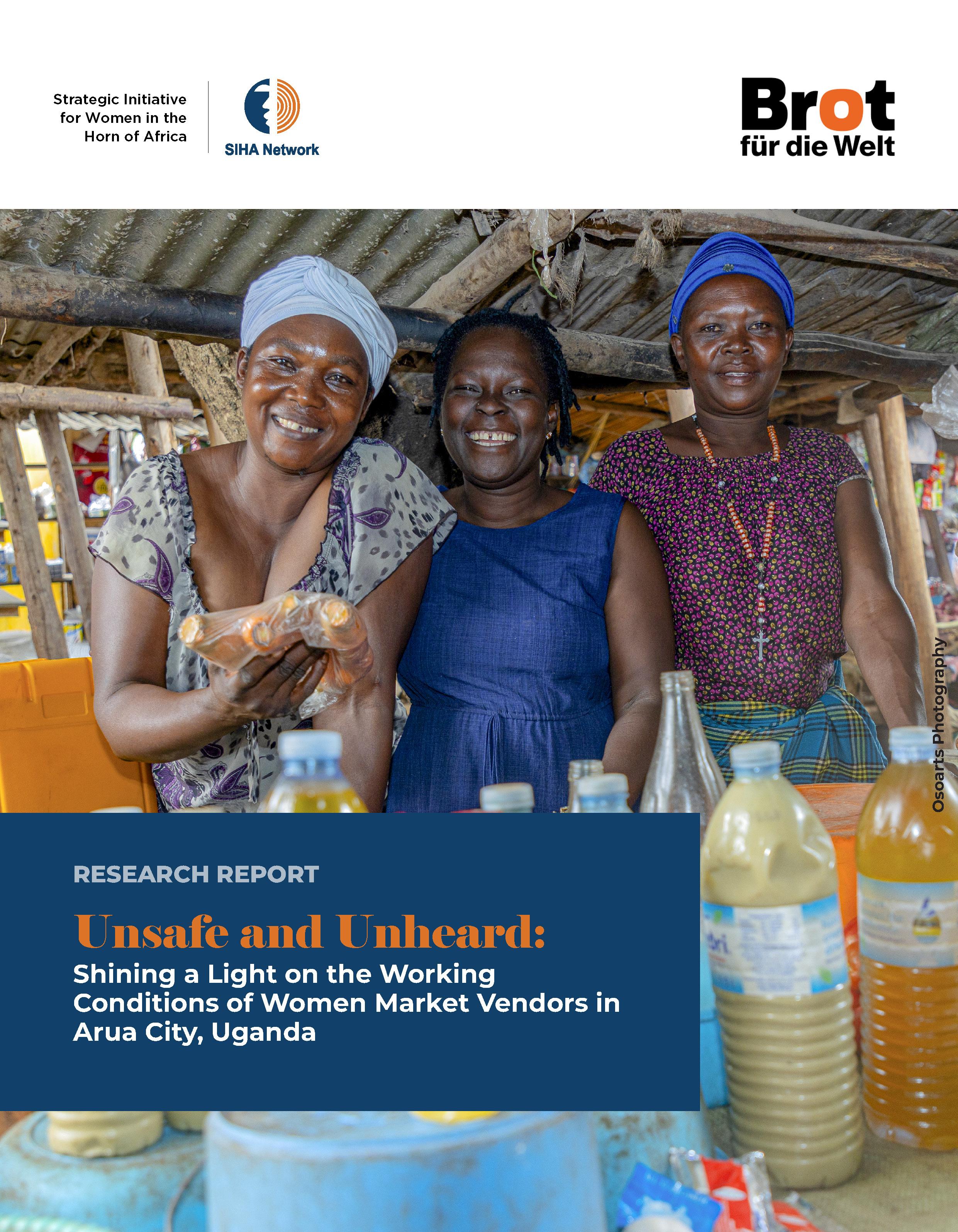




This research paper, titled “Unsafe and Unheard: Shining a Light on the Working Conditions of Women Market Vendors in Arua City, Uganda,” was made possible through the generous support of BROT für die Welt (Bread for the World). We are deeply grateful for their steadfast commitment to gender equality and the empowerment of women in Uganda.
We extend our sincere appreciation to Bayo Moses for leading the research, and to Faith Marie Sandby James for her editorial expertise. Special thanks also go to the study participants – the women market vendors for their invaluable contributions.
Our heartfelt thanks go to the SIHA Uganda staff, led by the Country Coordinator Jackie Bless Pinyoloya, for their coordination and guidance throughout the study. We also extend our sincere appreciation to the SIHA Regional Team including Hala Al-Karib, the Regional Director; Faizat Badmus-Busari, the Regional Programme Manager; Mercy Apiyo Owuor, the Regional Coordinator for Monitoring, Evaluation and Learning; Sandra Nassali, the Regional Advocacy and Communications Coordinator; and Ramatoulie Jallow, the Regional Research and Advocacy Officer, for their invaluable support and input.
This report should be cited as follows:
The Strategic Initiative for Women in the Horn of Africa (SIHA) Network, “Unsafe and Unheard: Shining a Light on the Working Conditions of Women Market Vendors in Arua City, Uganda,” 2025.

This publication was produced through the generous support of BROT für die Welt (Bread for the World). The views expressed in the report are those of the SIHA Network and do not necessarily reflect the official policies or positions of BROT für die Welt (Bread for the World) or their affiliated organizations.
Research complication: Bayo Moses
Cover photo: Lema Lasen
Design: Marce Digital Ltd
Conducted: 2023
Updated & Published: April 2025
All rights reserved. No part of this publication may be reproduced, stored in a retrieval system, or transmitted in any form or by any means without prior approval in writing from The Research Team and SIHA Network. This Paper is not a legally binding document. It is a collaborative informational and assessment document and does not reflect the views of any of the contributing partners in all its contents. Any errors are the sole responsibility of the authors.
Copyright © 2025 SIHA Network




CDP III The City (Arua City) Development Plan, Phase III (2021 – 2025)
CEDAW Convention on the Elimination of all forms of Discrimination Against Women
KII Key Informant Interview
LED Local Economic Development
LG Local Government
LGA Local Governments Act
LLG Lower Local Government
MSMEs Micro, Small and Medium Enterprises
NEMA National Environment Authority
PDM Parish Development Model Program
PWDs Persons with Disabilities
SIHA Strategic Initiative for Women in the Horn of Africa
TILED Trade, Industry and Local economic Development (LG Department)
TOR Terms of Reference
WMV Women Market Vendors

This report presents the findings of a knowledge-synthesis study conducted for evidence-based advocacy aimed at improving the working conditions of women market vendors (WMVs) in Arua City, Uganda. The study gathers information from various sources, including policy framework reviews, key informant interviews, and observational assessments, to understand the factors influencing WMVs’ working conditions in Arua City. It also seeks to provide recommendations for the improvement of these working conditions.
The information generated in the knowledge-synthesis study is intended to assess progress toward two specific objective indicators under SIHA Network’s projectStronger Together: Supporting a Cohesive Women’s Movement in West Nile Phase II Project: i) at least 75% of WMVs report better working conditions because of their advocacy efforts; and ii) at least 60% of the 400 WMVs report feeling safer and better protected from SGBV following the project intervention.
The study integrates information sourced through four main methods including policy framework analysis; ten key informant interviews (KIIS) with targeted actors within the city; observational assessments in nine Arua City markets supported under the Stronger Together Program (Arua-main market, Awindiri, Dadamu, Driwala, Ediofe, Lobida, Muni-site, Mvara-dri, and Social-center markets); and analysis and findings from the SIHA baseline study conducted in conjunction with the Stronger Together Program, which reached 170 participants (163 women and 7 men).
Overall, the study establishes that the working conditions for WMVs in Arua City are generally poor except for Arua-main Market where a well-planned and developed physical market structure has been established providing a safer physical working environment for WMVs. Poor overall working conditions in the markets are primarily due to the weak implementation of policy frameworks, inadequate self-knowledge among vendors regarding their rights, inadequate market facilities, and poor management practices and systems by both the city council and markets leaderships. The study also finds that the implementation, adaptation, and enforcement of policy frameworks related to market vendors in Arua City are weak, resulting in unsafe working conditions for WMVs.
Key market facilities such as drainage, parking, stalls, and shelter were found to be inadequate in most markets, posing safety risks for WMVs. Poor waste management and limited inclusion of persons people living with disabilities are also identified as major issues. The study further highlights the lack of adherence to market facility standards and irregular inspections, contributing to poor hygiene and the deterioration of market structures.

The report emphasizes the need for localized and strengthened policies; strengthened market leadership and conflict resolution mechanisms in the market. It further highlights the need for better implementation of policies, plans and by-laws at the local level; increased awareness on the key issues influencing working conditions in the markets, and a transformation of the prevailing mind-set regarding the rights and responsibilities of key actors like market leaders, local government, and WMVs. Additionally, the report calls for greater engagement and accountability from the City Council and other stakeholders to effectively address the challenges and injustices WMVs face. The study also recommends investing in market infrastructure and facilities that accommodate vendors living with disabilities, and the inclusion of vendors living with disabilities in key market leadership and decision-making positions.
In conclusion, this knowledge-synthesis study provides a holistic understanding of the challenges faced by WMVs in Arua City and offers clear recommendations for evidence-based advocacy. By addressing the identified issues and implementing the proposed solutions, significant improvements can be made to enhance the working conditions and safety of WMVs in Arua City.

To enhance the working conditions of women market vendors (WMVs), SIHA Network is committed to instigating positive change by catalyzing the creation and execution of localized policies that directly affect this demographic group. This initiative involves active engagement with various stakeholders, such as local policymakers, city authorities, and women’s rights organizations, among others.
SIHA Network’s primary objective in this study is to generate compelling evidence to support and strengthen the advocacy activities of WMVs. The analysis and findings of this study will draw on and synthesize primary source data from the SIHA baseline study for the Stronger Together Project, as well as key informant interviews (KIIS) and observational assessments in Arua City markets along with analysis of policies and by-laws of the Arua City Council. By synthesizing knowledge from both primary, observational, and policy sources, this study aims to identify provide documented evidence that can be used by WMVs in their advocacy for improved working conditions.
The team visited all nine markets within Arua City supported by SIHA Network under the Stronger Together: Supporting a Cohesive Women’s Movement in West Nile Phase II Project to carry out the observations. These nine markets are: Aruamain, Awindiri, Dadamu; Driwala, Ediofe, Lobida, Muni-site, Mvara-dri, and Socialcenter. Key informant interviews (KIIs) were undertaken with three market vendor association leaders (two women and one man) – one each from the Arua-main, Awindiri, and Dadamu market associations.
The findings from these key informant interviews (KII) and other primary data were synthesized with analysis of legal and policy frameworks applicable in Arua City, Uganda. Interview respondents included four Arua City staff members (both technical and political), representatives from three civil society organizations (CSOs), and three representatives from market vendors’ associations and leadership. The interviews focused on the gender responsiveness of policies and by-laws, the working conditions for women market vendors, financial literacy, government programs, and the involvement of vendors in decision-making processes.

A comprehensive methodology was employed, including a review of existing policy frameworks, key informant interviews, and observational assessments of the working conditions of WMVs and key market facilities. This approach aimed to gather information from multiple sources to provide a holistic understanding of the factors influencing the working conditions of WMVs in Arua City.
The methodology is comprised of three main components:
i. Review of Existing Policy Frameworks: An extensive review of existing policies, regulations, and frameworks related to market vendors and market infrastructure was conducted. An integrated approach of two primary knowledge-synthesis methodologies – systematic reviews, and realist synthesis – was applied, to provide a holisticunderstanding of the status quo and of the factors influencing WMVs’ working conditions. This review aims to inform the development of effective, actionable interventions and recommendations.
ii. Key Informant Interviews (KIIs): Ten KIIs were conductredwith targeted key actors within the city. The targeted respondents included market management and vendor leadership representatives from Arua-main, Awindiri, and Dadamu Markets; Arua City Council technical and political staff; and representatives from West Nile Civil Society Network – WECISNET (a local CSO), and the media (Radio Pacis). These interviews captured insights and perspectives on the working conditions of WMVs and the role local policy frameworks have played in creating and maintaining these conditions.
iii. Observational Assessments: Direct observations were conducted across the nine markets in Arua City. An observation guide with specific criteria was used to assess the working environments facing women market vendors, including factors such as cleanliness, safety measures, accessibility, infrastructure maintenance, and availability of facilities.
iv. Integration of the Stronger Together baseline study findings: The study integrates findings from a SIHA-conducted baseline at the project’s outset.. This baseline study covered 170 stakeholders across the markets in Arua City (163 women and 7 men). Of the participants, 12.9% were aged 18-35, 67.1% aged 36-50, and 20.0% were over 50 years old. 33 participants (19.4%) of the respondents identified themselves as people living with a disability, primarily

physical, hearing or visual impairments. Respondents evaluated key factors influencing the working conditions of WMVs in Arua City using a Likert scale (detailed in Annex 6.1). Data collected through KIIs and FGDs was compiled, cleaned, analyzed, and interpreted to understand the status quo of working conditions for WMVs in Arua City markets.
This section explores the various factors that influence the working conditions of WMVs in Arua City, including market safety, violence and sexual harassment, market leadership inclusivity or lack thereof, and access to finance. The section also addresses cross-cutting issues such as the additional layers of challenges and disenfranchisement faced by women vendors living with disabilities. Findings are discussed in relation to existing national and local legal and policy frameworks, to provide recommendations for holistic improvement of the working conditions of WMVs in the Arua City.
This subsection evaluates key market facilities that influence the safety and convenience of WMVs. Understanding the current market infrastructure is crucial for identifying gaps and guiding the interventions by the city council and private investors. These include the planning and development of lock-ups, stalls, warehouses, wholesale facilities, and restaurants across Arua City.
i. Drainage System in the Markets: Among all the markets assessed, Arua-main Market was rated highest, reported to be well-designed and functional. Lobida Market received a ‘very good’ rating, while Ediofe and Muni-site Markets were rated a bit lower, however still reported to be ‘good.’ In contrast, Awindiri Market was rated ‘poor,’ and Dadamu, Driwala, Mvara-dri, and Social-center Markets lacked any surface drainage systems entirely. The absence or inadequacy of drainage infrastructure in most markets highlights a critical gap in basic service provision, with dangerous potential consequences for sanitation, public health, and the overall working conditions of vendors.
ii. Market Access Roads: All nine markets have access roads, however, their quality varies considerably. The access roads to Ediofe and Social-center Markets were rated as ‘excellent’ with well-maintained and easily navigable access routes. In contrast, Awindiri, Dadamu, Driwala, Lobida, and Muni-site Markets received fair ratings, indicating issues such as uneven surfaces or limited connectivity. Arua-main and Lobida Markets, despite having access roads, were rated due to challenges such as unregulated traffic flow and illicit use of their main access routes i.e. private or commercial vehicles blocking the roads. These issues compromise the functionality and safety of the roads, especially during peak market hours.

Market Parking Areas: The parking areas near the Awindiri, Lobida, and Muni-site Markets were rated ‘fair,’ while Arua-main Market’s parking area was rated ‘excellent.’ By contrast, Dadamu, Ediofe and Mvara-dri Markets lacked any designated parking area.
i. Rubbish Bins: Six markets (Dadamu, Driwala, Ediofe, Muni-site, Mvara-dri, and Social-center) did not have rubbish bins at all. While Arua-main, Awindiri, and Lobida Markets, have rubbish bins, none received a ’very good’ or ‘excellent’ rating. The market vendors report that the bins are few, sparsely located, and poorly maintained. At times, the vendors resorted to packing rubbish into polythene sacks andstoring it under their stalls, due to the inadequate waste management setup and long distances between bins.

ii. Rubbish Pits, and Garbage Skip Bins: Four markets do not have rubbish pits or skip bins. While Arua-main, Awindiri, Dadamu, Driwala, and Ediofe Markets have rubbish pits or skip bins, waste management is poor. Many pits and skip bins were observed to be over-flowing and waste sorting is non-existent across all markets.
Using a 5-point Likert scale – with ‘poor’ being the lowest rating (1) and ‘excellent’ being the highest rating (5) – Awindiri, Driwala and Ediofe markets were rated ‘poor’ in terms of their garbage collection and management facilities; Dadamu Market was rated ‘fair’ while Arua-main Market’s gargabe collection bins were rated ‘good.’
According to findings from the baseline study for the Stroger Together Project, indicate that 40.8% of wastes across markets are left in the open, 28.3% are thrown into rubbish pits, and only 17.3% of rubbish are collected by the city council, while 13.1% use other methods of waste management.

“The market space is not enough, vendors only use rubbish bins to collect rubbish and then dump afterwards.”- WMV, Lobida Market

“The rubbish pit is in a bad condition; the rubbish pit is so full and has not been emptied for a year now.” – WMV, Awindiri Market
iii. Availability of Toilet and Latrine Facilities: Eight of the nine markets have latrine or toilet facilities within the market premises. Muni-site is the only market in which no toilet facilities are available. Ediofe Market had a ‘very good’ rating for its toilet facilities, while toilet facilities in Driwala were rated ‘poor’ indicating a very low level of quality and user satisfaction.
Arua-main, Dadamu, Mvara-dri, and Social-center Markets were rated ‘good’ for the toilet facilities, suggesting that basic requirements and minimum standards are being met.
The low ratings in some markets were attributed to poor maintenance. For example, in Driwala market, the toilet is often reported to be almost to the point of overflow.
WMVs also raised concerns that some toilets are not labelled, leading to men and women using the same toilet stalls.
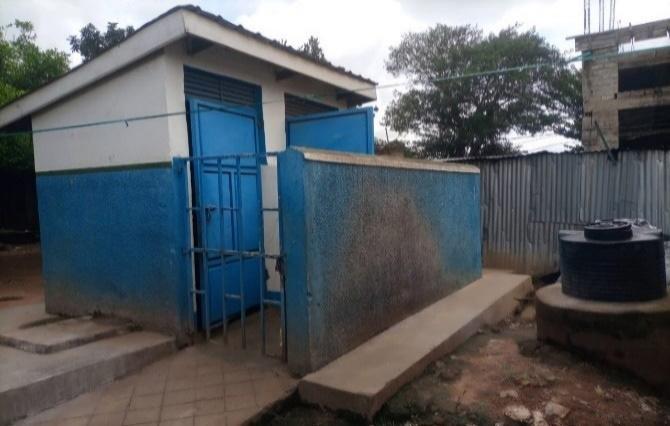

iv. Access to Safe Water in the Markets: Seven of the nine markets have functional potable water facilities, such as running tap water from the National Water and Sewerage Cooperation (NWSC) or water pumps (boreholes). Mvaradri and Muni-site Markets do not have any functional potable water facilities or services. Most water facilities were provided and managed by private service providers to ensure sustainability. Water facilities in Awindiri, Dadamu, Ediofe, Lobida, and Social-center were rated ‘very good’, whileDriwala Market’s water facilities were rated ‘poor.’ Arua-main Market’s water facilities were rated ‘excellent’ indicating a higher level of quality and safety.
v. Hand Washing Facilities: Findings showed that six of the nine markets have functional hand washing facilities (Arua-main, Awindiri, Driwala, Ediofe, Socialcenter and Muni-site Markets), while Mvara-dri, Dadamu and Lobida Markets lack such facilities. Two markets (Awindiri and Driwala markets) were rated ‘poor’ for the condition and effectiveness of the hand washing facilities, while the rest of the markets with hand washing facilities were rated ‘good,’ indicatingthat basic requirements and minimum sanitation standards are being met, namely access to clean water and soap.


a) Market Fencing Structures: Six of the nine markets are well-fenced, while the remaining three (Lobida, Muni-site, and Mvara-dri) do not have fencing structures of any kind. Fencing materials vary, ranging from lockups or barbed, to permanent walled/building structures, like those in Arua-main Market.

‘It’s lockups that surround the market and there is no proper gate to secure the goods and products of vendors at night.’ - WMV, Awindiri Market,
b) Market Shade and Shelter Structures: Eight of the nine markets have some form of structural shelter to protect from sun and rain. However, many shelters are in poor condition, and and numerous vendors still operate in open areas as roadside vending is also common in Arua City.
The baseline study found that over 98% of the 170 respondents reported that safety measures are unavailable. Additionally, the majority of respondents – 118 WMVs –reported feeling that their safety issues are not prioritized by market management or local authorities.
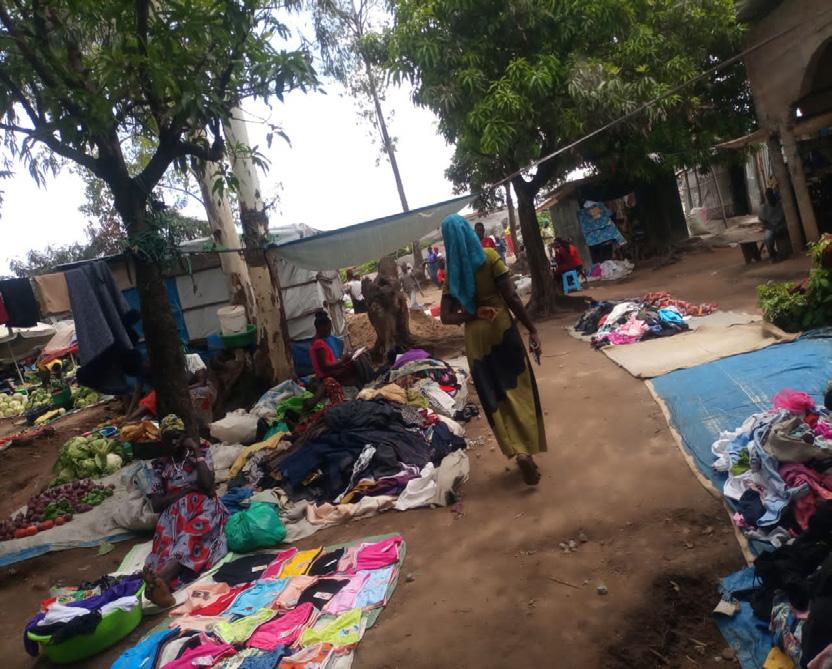

‘The market shelter available is very small and cannot accommodate all the vendors in the market.’ - WMV, Mvara-dri Market
‘The market shelter is not enough and it is too close to that roadside and that in case of any accident at the roadside, vendors can be involved as well.’ - WMV, Mvara-dri Market
c) Market Storage Facilities: Five of the nine markets have storage facilities, either integrated within the market or privately owned. Dadamu, Driwala, Muni-site, and Mvara-dri Markets lack any storage facilities at all. Arua-main is the only market to have received an ‘excellent’ rating for its onsite storage facility. Lobida market was rated ‘good,’ while others received lower ratings, due to poor conditions, distance from the market, or lack of security.

d) Electricity Connection: All markets markets except Dadamu have electricity connections, usually from nearby lock-up shops in the vicinity. Electricity access was generally rated ‘good’, except in Muni-site Market where it was rated ‘poor.’ Arua-main and Ediofe Markets were rated ‘excellent’ in terms of electricity services.
In Driwala and Awindiri Markets vendors reported that only a few vendors with kiosks have access to electricity, leaving out most vendors. Meanwhile in Muni-site and Mvara-dri markets, vendors do not have access to electricity, despite the existence of power lines not far from the markets.
e) Designation of Spaces by Product Type: All markets except Mvara-dri have designated areas for different product categories. The designation of zones for the sale of particular product types received on average a ‘good’ rating, however, many vendors explained that there are issues with designing the system this way. Namely, vendors often sell multiple products, and if their products are categorized differently, they cannot follow the designation system, forcing vendors into difficult and costly choices. Another issue that was raised to a lesser degree was overcrowding in designated spaces..
f) Security Services: Only three markets—Arua-main, Social-center, and Awindiri— have security services. Awindiri Market was rated ‘poor,’ Arua-main ‘good,’ and Social-center ‘excellent.’ Arua-main is the only market that has a designated police station offering security services. In Social-center, vendors hired guards themselves to protect their merchandise at night.
g) Availability of Market Stalls: Five markets—Arua-main, Awindiri, Driwala, Ediofe and Lobida have stalls, while the remaining four markets do not. Stalls were generally rated ‘fair’, except for Arua-main which received an ‘excellent’ rating.
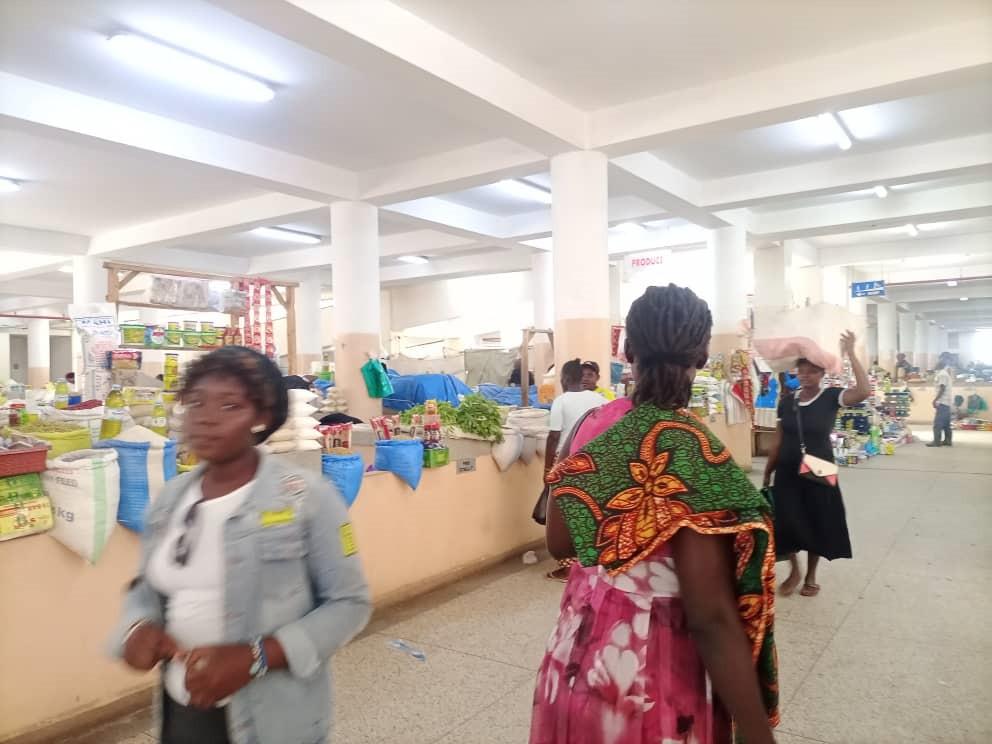

Further findings revealed that 88% of vendors do not have safe and protective stalls for displaying and selling their goods, and only 22% reported having protective stalls in place. This poses safety and hygiene risks due to harsh weather and inadequate infrastructure.
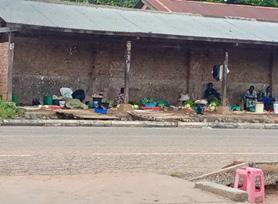
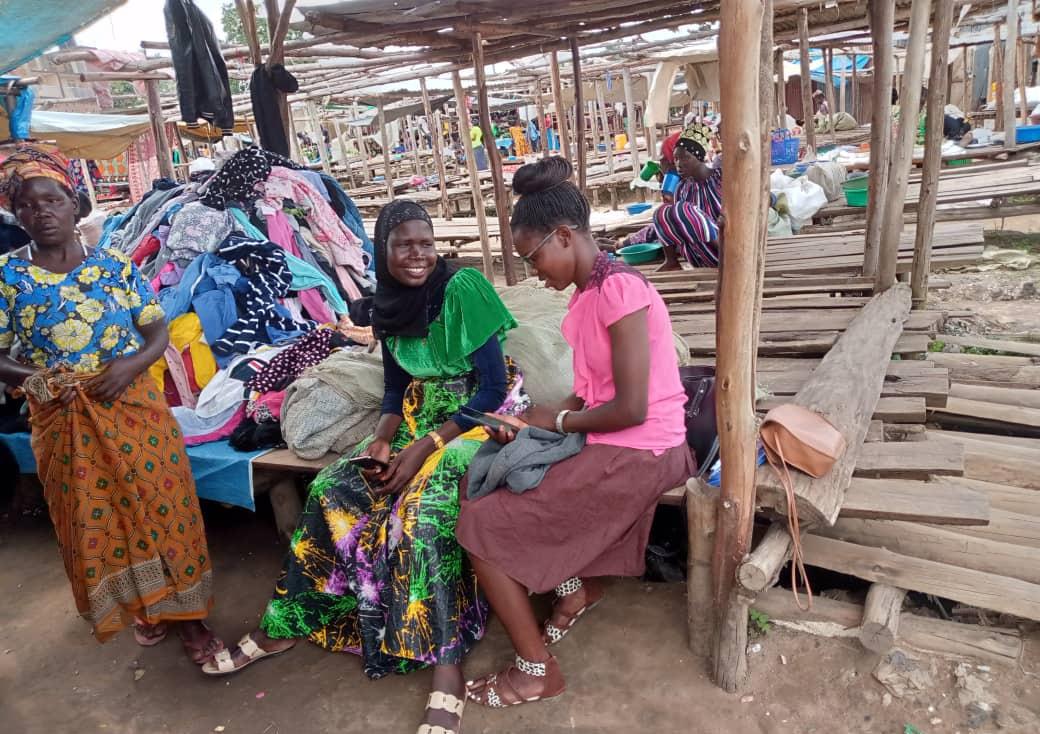
Many of the WMVs who contributed to this research through interviews, surveys, or focus groups reported having experienced harassment and violence first-hand in the markets where they work. An estimated 62% of the baseline study participants reported experiencing some form of physical/psychological violence or harassment within the market, while 38% reported having never experienced any form of physical/ psychological violence.
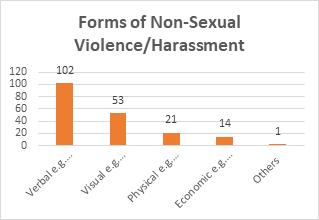

During the baseline study102 WMVs reported experiencing verbal aggression or harassment in the market such as hurtful comments, mean jokes, threats, insults, bullying, and intimidation. Additionally, 53 WMVs reported experiencing visual harassment (e.g. intrusive stares), 21 reported experiencing physical harassment (e.g. pulling/ pushing, beating/hitting), and 11 WMVs
experienced payment related violence (e.g. customers’ refusal to pay or forcibly removing vendors from their stalls to avoid payment). The findings reveal that fellow WMVs were the most frequent perpetrators of non-sexual-violence and harassment, accounting for 91 out of 157 responses. Other perpetrators included customers, male market vendors, tax collectors, and suppliers such as lorry drivers.
The study also found that cases of non-sexual violence (broadly categorized under ‘violent crime,’ including both attempted and actual assaults within the marketplace) are rarely reported at all. Indeed, a significant majority—84%—of WMVs interviewed, did not report the non-sexual violence they experienced. Most believed reporting was a waste of time, convinced that no serious action would be taken by authorities. Meanwhile, 6% did not know how or where to report such cases, another 6% expressed distrust in key support actors such as the police, market leaders, or association representatives, and 3% feared retaliation for speaking out.
Among the minority of these cases in which survivors or witnesses decided to report the violence, 36 respondents made their report to market leaders, 28 reported to fellow women vendors 22 reported to family members or friends, and only 8 respondents reported to the police. A few cases were also reported to male vendors and local women’s rights organizations.
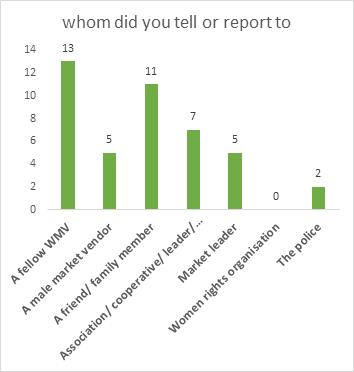

Sexual violence and harassment remain prevalent in Arua City markets. In the baseline study, 17.8% of respondents reported being subjected to sexually suggestive gestures or expressions (e.g., gestures with the hands, facial expressions ) in the market, while 82.2% reported not having experienced this form of harassment. Additionally, 11.8% reported receiving offensive or sexually explicit comments, suggestions, or jokes, about their bodies or sexualityt, 4.7% reported receiving unsolicited social media clips, videos, pictures or messages with offensive and sexually explicit content.
Further findings showed that 5.9% of WMVs had received repeated unwanted invitations to go out for meals or drinks even after saying ‘no.’ 3.6% reported persistent invitations for sexual intercourse despite their refusal. Alarmingly,1.2% of WMVs had experienced physical force or threats aimed at coercing them into sex, and 2.4% reported being threatened with punishment if they did not comply with the sexual demands or invitations.
When asked whether they reported these experiences, only 9% of affected WMVs said they had reported incidents of sexual violence or harassment. The remaining 91% did not.

Of the 43 WMVs who did report, 13 confided in fellow WMVs, 11 told a friend or family member, 7 informed an association or cooperative leader, and a few others reported to male market vendors. Only two respondents reported to the police.

Why WMVs do not Report Sexual Violence Cases: Regarding reasons for not reporting, 69% (44 of 63 responses) felt that it was a waste of time. Another 11% said they did not trust the available authorities (e.g., police, market or association leaders), while 11% said they did not know what to do or where to seek help. Finally 9% feared potential backlash or negative repercussions if they reported such incidents.
Although women hold leadership roles in Arua City market structures, the findings suggest a lack of confidence in these structures’ ability to resolve conflict effectively. This is either due to weak institutional frameworks or a lack of awareness among vendors about the roles, responsibilities, and conflict resolution mechanisms available through these leadership structures.
All the nine markets have leadership structures in place, and 90% of the 170 respondents in the baseline study confirmed that women participate in market leadership.
In a multi-response section of the study, respondents noted that women hold various influential roles—including chairpersons, vice-chairpersons, treasurers, secretaries, and members of market committees. Furthermore, 70% of 169 respondents stated that women meaningfully participate in decision-making within the market management committees.
On a Likert scale, only Arua-main, and Awindiri Markets received an ‘excellent’ rating for their overall leadership, while Driwala, Muni-site, and Social-center Markets obtained the lowest rating (‘fair’) indicating existing capacity gaps in market leadership that must be addressed to ensure efficient and effective market functioning, particularly in improving working conditions for WMVs.

Figure 4: Number of respondents who reported the various leadership positions occupied by women market vendors across the markets in Arua City – Multi-response (Source – Stronger Together Project Baseline Study).

a) Reasonable Accommodation for Vendors with Disabilities: This study assessed whether the markets (including respective management bodies and vendor associations) in Arua City have made provisions for reasonable accommodation of vendors with disabilities—specifically, through the allocation of more accessible stalls and local disability support services. Researcher observations indicate that none of the markets have implemented concrete measures to accommodate vendors with disabilities. In Arua-maint and Dadamu Markets,the leaders of the vendor associations claimed to have made accommodations for vendors with disabilities, but no supporting evidence was observed.
According to the Stronger Together Project baseline study findings, many of the WMV respondents live with some form of disability, including vision or hearing impairment among others.
b) Toilet Accessibility for People Living with Disabilities: Only Arua-main and Driwala Markets have accessible toilet facilities for people living with disabilities. The other seven markets lack accessible toilet facilities. Responses using a 5-point Likert scale, on average reported Driwala market’s toilet facilities to be ‘fair’ while
Arua-main market was rated ‘very good.’ The higher rating can likely be attributed toArua-main market’s well-designed, and constructed modern toilet facilities including ramps, handrails, and a designated toilet facility for PLWDs..
c) Accessible Structures (Ramps and Guard Rails): Across the nine markets, only Arua-main Market has standard accessibility structures (ramps and guardrails) to ensure accessibility for all within the market premises. In Lobida Market, some ramps—mainly installed by private shop owners—exist and were generally rated ‘fair,’ although most were of substandard specifications. Awindiri, Dadamu, Driwala, Ediofe, Muni-site, Mvara-dri, and Social-center markets have no accessibility structures. Notably, Muni-site has no permanent market structures or facilities at all. The accessibility structure ratings are summarized in the chart below.
Table 2: Rating of Accessibility Structures (Ramps and Guard Rails)
Markets with No Accessibility Structures (Ramps, and Guard Rails) Total Awindiri, Dadamu, Driwala, Ediofe, Mvara-dri, Muni-site, and Socialcenter markets

The level of financial literacy among market vendors in Arua City varies. While some have a basic understanding of financial concepts, many lack essential financial skills due primarily to a lack of exposure to financial education, low levels of formalized education, and discriminatory treatment when seeking access finance. Although vendors understand basic business operations, they often lack knowledge in areas such as budgeting, saving, and financial planning. Financial barriers and challenges faced by women market vendors include limited access to capital, high-interest rates, seasonal price fluctuations, and vulnerability to risks. Government programs intended to support WMVs’ financial access, the Bank of Uganda, Emyooga and PDM, National SpecialGrant for Persons with Disability, Parish Development Model, and Women Entrepreneurship Program. While these programs exist, their efficacy

is greatly hindered by challenges such as lack of awareness among beneficiaries, structural friction and lack of accountability, poorly organized leadership mechanisms, and logistical difficulties in recovering funds. In Arua-main Market, the uptake of programs led by women market vendors has been positive but still relatively low, with some vendors expressing dissatisfaction with government efforts.
A) Section 57 of the Environmental Health (Public Health Act) Regulations stipulates that “no dwelling or building shall be erected on any area of land in any urban sanitary district unless and until the owner or lessee thereof has filled in and levelled the area to the satisfaction of the local authority and taken such measures for the general drainage of the area as may be required by the local authority.”
A 2019 study by Andrew O.A. found that poor drainage contributes significantly to mental illness and physical health problems. Poor drainage promotes vector and vermin infestations, spreading diseases such as cholera and typhoid, and increasing infant mortality.
With the exception of Arua-main market, most markets in Arua City do not comply with the provisions of the Public Health Act, as most have nonexistent or poorly maintained drainage systems. This contributes to poor hygiene in the markets and increasedhealth risks for both vendors and customers.
B) Commonly cited causes include garbage-clogged channels, lack of proper drainage systems, and irresponsible vendor behavior. . Some markets, like Mvaradri, rely on roadsides as drainage systems, while in Arua-main Market features permanent, well-planned drainage.

C) Section 3.6.6 of the Arua City Development Plan III (2021-2025) and in full alignment with the NDPIII objectives, aims to consolidate and increase productive infrastructure, including the optimization of transport infrastructure and services through investment in the transportation sector. Specifically, the city plans to invest 1.44 billion shillings to:
1) Construct and upgrade strategic road infrastructure (agriculture, tourism, health, education, markets, and other facilities),
2) provide non-motorized transport infrastructure within the urban areas, and
3) expandexisting road transport infrastructure within the city.
WMVs raised concerns over road accidents, burglary, and unregulated blocking of access roads, particularly in Lobida, Arua City, Awindiri and Social-center Markets, where boda-boda riders whoand hawkers obstruct entry. This compounded by markets often being located dangerously close to main roads or highways and poor maintenance of the markets’ access roads.
The road leading to the market is well constructed but people tend to use it for parkingmaking it congested.’- WMV, Arua-Main Market
While road projects such as the Enyau Bridge upgrade are underway, none specifically target the markets. For example, access to Driwala Market from Ociba Primary School continues to be in very poor condition. Unregulated road usage is worst in the key markets in the central business district of the city (Arua-main and Lobida Markets).
D) Uganda’s Local Governments Act (LGA), 1997, mandates that markets fall under the purview of lower local governments and city or municipal division councils. Accordingly, Section 30 of the LGA provides for services listed under Parts 2, 3, 4 and, 5 of the Second Schedule to the Act including, the establishment, administration, management and collection of revenue from markets as falling within the mandate of local governments. Part 3 of the Second Schedule of the LGA, stipulates the functions and services that for which urban councils are responsible, including, waste regulation and disposal..
E) Uganda’s National Environment Act, 2019 mandates the National Environment Authority (NEMA) to ensure that all developments adhere to acceptable environmental standards, including solid waste management, water and sanitation systems and practices. Therefore, disposal of garbage, solid and liquid waste generated in markets must comply withestablished regulations and minimum standards to protect the health and safety of market users and vendors.

Section 96 of Part VIII of the National Environmental Act, stipulates that
1. A person who generates or handles waste shall be responsible for its proper management in accordance with this Act, the principles of the circular economy referred to in Section 5(2) (p), and the waste management hierarchy and measures prescribed by regulations.
2. The person responsible for managing waste under subsection (1) shall take such steps as are necessary to prevent pollution arising from such management and where pollution occurs, to minimize the consequences of the pollution on human health and the environment.
Section 97 of the Act also provides for prohibition of littering and stipulates the following from subsections (1-5) ;
1. Littering is prohibited.
2. A person who owns or occupies any dwelling or commercial premises is responsible for waste generated at those premises until it is collected by the authorized person.
3. A person driving a vehicle is responsible for the sanitary condition of the vehicle and for the waste generated in the vehicle.
4. A person shall not place, deposit or allow any waste to be placed or deposited on his or her premises or on private property, on a public street, roadside, or in a ditch, river, stream, lake, pond, canal, channel, park, gulch, ravine, excavation, or other place where it may be or become a public health nuisance.
5. Subsection (4) shall not be construed to prevent the approved placement of waste for collection purposes in accordance with this Act.
F) Section 2.6.3 of the Arua City Development Plan III on management of solid and liquid waste, recognizes the challenges of waste management in the city.. It states that improvement in ‘waste management has been pursued through waste collection placing waste bins andgarbage banks closer to the markets. Some of the markets are provided with trucks for transporting waste to the relevant facility for storage, sorting, and recycling. However, systems for waste management require strengthening to shore up the still wide gaps between the ideals of the Act and the lived realities in practice.’
The state of waste management in the city markets continues to be plagued bychallenges in waste management, including weak systems for collection, sorting, and recycling. Despite available garbage banks and trucks, market-

level practices remain poor. The problem is twofold – on the one hand vendors have developed fatalistic attitudes toward waste disposal, and on the other, the inefficient city council systems continue to be unable to manage the growing waste piles within the city. Addressing this requires educating vendors, investing in waste facilities, and strengthening enforcement through market structures.
G) Chapter 3, Subsection 11.1 of the National Physical Planning Standards and Guideline, 2011 requires market sites to make provision for customer parking (if there is no public car park) and space for supplier delivery services.
‘People park vehicles by the roadside which causes congestion that can lead to accidents. Another WMV in Lobida market added that ‘the market space is not enough to allow them to create a space for parking yards and since the market is next to the roadside, vendors and customers park for waiting, loading or offloading goods from the roadside’ – WMV, Awindiri Market
H) Section 3.11.1. of the National Physical Planning Standards and Guidelines 2011, requires that ‘most commercial areas have a site zoned for a market, and that markets will only be permitted on such designated plots. Market sites must contain provisions for customer parking (if there is no public car park) and space for supplier delivery services. Markets must be provided with running water, sanitation facilities, drainage, and waste disposal, as well as covered and hygienic stalls that are deemed adequate by the local authority.’ Chapter 7 of the guidelines further outlines site and layout standards for market design..
However, implementation of these policy frameworks in Arua City is grossly inadequate. Many markets—such as Mvara-dri and Muni-site—are located in non-gazetted areas, and most market constructions fail to follow the prescribed layouts and facility requirements. This hinders proper planning, design, and the establishment and management of essential infrastructure including safe water, sanitation, drainage, hygiene facilities, access roads, fencing, toilets, and parking. These deficiencies directly compromise the safety and well-being of Women Market Vendors (WMVs), contributing to poor working conditions. .
I) The Uganda Land Act, Cap. 227 and the Land Acquisition Act, Cap. 226: The Uganda Land Act, 1998 (as amended) vests land in Uganda to the people in relation to the four land tenure systems. Many markets are located on private land. For the urban councils to own these markets, they need to buy them. This poses the dilemma of whether to leave the markets under the control of the landowners and regulate their management and administration or to require local government to purchase them.

Section 4 of the Markets Act, 2023 - Establishment of public markets, among other sub-sections, stipulates that:
1. A local authority may, by resolution, establish a public market within its area of jurisdiction.
2. A local authority shall, before passing a resolution to establish a public market, ascertain—
■ The physical location of the intended market,
■ The ownership of land on which the public market is to be established,
■ Availability of funds,
■ The category of the market to be established as prescribed in section 3,
■ User rights, and
■ Compliance with the Physical Planning Act, 2010 and other applicable laws.
It is clear from the observed state of markets and the resultant state of working conditions for WMVs in the markets, that most markets were not planned nor are they being maintained in accordance with the relevant local and national laws, leading to ambiguities in their ownership, operationalization, development and routing management. This has directly impacted the state of working conditions in these markets, especially for the WMVs.
J) Accordingly, in the City Development Plan III, Arua City has outlined its intention to secure ownership of all institutional pieces of land (schools, health centers, markets, division and city headquarters) through survey and titling by 2025, with funding from the city council (see Annex 1: LGDP Results Framework).
Accordingly, in Section 3.2 of Arua City of the City Development Plan III; the city council has planned to improved utilization of Sustainable Energy and ICT by increasing the proportion of the population accessing electricity by connecting institutions (schools, health centers, markets and lower local governments) to the national electricity grid.
Findings indicate that inspections are conducted inside the markets. These inspections—typically conducted by local government staff, health inspectors, engineers, and police—cover sanitation, management and administration, health,hygiene, and security. However, analysis of KII data revealed that these inspections are irregular, unstandardized, and lack enforceable outcomes, resulting in persistently poor hygiene and infrastructure conditions. If not

improved, this presents a serious long-term risk of harm, injuries, infestations, disease outbreaks, and general health crises—particularly for WMVs, who constitute the majority of daily market users.
When asked to suggest areas where regulations need to be strengthened to better support WMV, interviewees suggested a implementing a policy designed to ensure fair and transparent stall allocation in markets, providing adequate infrastructure and facilities in order to cater to the health and safety needs of all the vendors, with specific consideration for women and people living with disabilities (e.g., childcare centers and disability access),,\ improving the sanitation and health condition in markets especially garbage disposal and waste management, avoiding multi-storey markets, as upper floors remain underutilized, and s tronger policy implementation at local levels, especially in market governance.
A) Uganda ratified the Convention on the Elimination of All Forms of Discrimination Against Women (CEDAW) in 1985.
B) The 1995 Constitution of Uganda emphasizes gender equality under Section 6, within the Chapter on Fundamental Rights and Freedoms .
C) According to Section 19 (5) of the Markets Act, 2023,, the Head of a Department shall be responsible for:
■ Ensuring proper organization, sanitation and orderliness of workspaces, shops, pitches or stalls under the respective department,
■ Vetting of new vendors into the department, and
■ Handling disputes within the department.
D) Uganda has several laws and policies targeting workplace-specific SGBV, including:
■ The Employment Act (2006) – Sections 5 (Discrimination) and 6 (Sexual Harassment),
■ The Gender Policy (2016), and
■ The National Action Plan on Elimination of Gender-Based Violence (2016).

E) Arua City Development Plan Phase III (2021-2025), Section 2.5 - Community Development and Social Protectionidentifies factors that promote discrimination and stigma against marginalized groups including PLWDS, women, and youth. The play aims to address and improve this status quo by enacting by-laws to address harmful cultural practices, implementing targeted programs like vocational training, youth entrepreneurship initiatives, and supporting household income programs under Operations Wealth Creation (OWC).
Despite these frameworks, enforcement remains weak in markets, endangering WMVs. There is a clear need to localize and strengthen policy implementation at the market level.
Interviewee participants in this study confirm that most markets have by-laws on management, hygiene, conflict resolution, and leadership—but these are poorly enforced. Strengthening market governance, leadership, referral pathways, and egalitarian conflict resolution mechanisms is critical.
Arua City Council’s promises in the CDP III—especially regarding addressing inequalities for women and youth—have largely gone unfulfilled. No new ordinances or by-laws have been enacted. Though programs like Emyooga, PDM, National Special Grant for PWDs, and the Women Entrepreneurship Program exist, their impact is minimal due to limited awareness among those eligible for assistance, weak and uncommitted leadership in the City Council structures, lack of transparency, particularly around fund recovery, delayed access to funding and grants due to bureaucracy, and limited skills among beneficiaries to properly utilize the financial support.
Therefore, the City Council and other duty bearers must be held accountable for the implementation of strategic development interventions, and more so for the ongoing livelihood enhancement programs in the city.
F) Section 10 of the Uganda Persons with Disabilities Act, 2020, provides for the establishment of accessibility in all publicbuildings. Specifically, the Act mandates that:;
1. An owner or a person in charge of a building to which the public is allowed access shall, subject to the requirements of the laws on building standards and other relevant laws, provide appropriate access for people living with disabilities to the building,
2. in subsection (1) “provide appropriate accessibility for persons with disabilities, to the building” means -
■ putting in place accessible and easy to find entrances which are connected to accessible pathways and parking areas,

■ providing safe and accessible toilets, urinals and bathrooms,
■ providing safe and well dimensioned staircases with appropriate railing, accessible elevators, and
■ where necessary, providing ramps.
Only Arua-main market has facilities for that are sufficiently accessible for PLWDs. . Despite the presence of vendors with disabilities, prevailing attitudes, practices, and accommodations remain inadequate. There is an urgent need to reasonably accommodate the vendors living with disabilities, by addressing their specific needs to enable them to fully and meaningfully participate within the markets on an equal basis with others.
Some respondents also expressed that certain toilet designs by the City Council fail to consider PWDs, citing a lack of consultation during the design process. For example, local government stakeholders admitted that in Muni-site Market, PWD needs were not properly considered, illustrating the exclusion of vulnerable groups.
1) The City Council should conduct a comprehensive assessment of market facilities and develop plans for their development, operation, and maintenance in accordance with existing legal and policy frameworks. For example, they should establish market stalls, sheds, and fences, and ensure proper maintenance of drainage systems, parking areas, access roads, and sanitary facilities.
2) Improve waste management infrastructure in markets and educate vendors on proper use of facilities, which may also provide economic opportunities through recycling. This should include installing bins, skips, rubbish pits, and implementing waste-sorting and recycling mechanisms.

3) Create disability-inclusive policies and market by-laws, enhance accessibility, and prioritize the rights and needs of PLWDs in market operations. For example, allocating accessible stalls to vendors with disabilities and installing ramps, guardrails, and other features that make washroom facilities accessible.
4) In tandem with the first recommendation, the City Council must strengthen regulations and enforcement to ensure compliance with legal and policy standards for market management, sanitation, health, and hygiene (The Markets Act; The Public Health Act, The Physical Planning Act, and National Environment Act etc). There is a need to institute and implement strict regulations for the markets’ management and administration, sanitation, health, hygiene, and security. Regular inspections should be conducted to ensure compliance, with with practical recommendations and enforceable guidelines provided to improve market conditions and infrastructure.
5) Implement existing laws and policies to protect women against violence and harassment in the workplace, ensuring perpetrators are held accountable. This includes enforcing the Employment Act of 2006 and the Gender Policy of 2016.
6) Establish a safe reporting and redress mechanism for all forms of harassment, violence, and conflict in the market, providing support services to affected vendors. This should include setting up a helpline, designated reporting centers, and offering counseling and legal aid to survivors.
7) By extension, local government should invest in the training of first responders who interact directly with WMVs who survive violence, harassment, or conflict in the market, to ensure effective assistance and case management. This includes ensuring an awareness of the referral pathways and services, thereby rebuilding survivors’ trust in the system to help them, rather that treating them with blame or indifference.
8) Develop and implement ordinances and by-laws specific to the issues faced by WMVs, incorporating their input to ensure effectiveness. These regulations should cover areas such as conflict resolution, cleaning,hygiene maintenance, and enforcement of these rules.
9) Improve financial support mechanisms for WMVs by enhancing awareness, promoting financial literacy skills, collaborating with stakeholders, and adapting financial services to their needs. This should involve improving the effectiveness of government programs and engaging with financial institutions and non-profit organizations to provide tailored financial products and services for WMVs.
10) Conduct training and awareness programs for vendors on gender equality and the prevention of sexual harassment and violence to promote respect and safety. Market leaders, association representatives, and cooperative leaders should also be included in these programs to address internal conflicts and ensure contextualization of program design and structure.
11) Promote women’s leadership in market management through capacity-building initiatives and by strengthening women’s associations and cooperatives. This should involve providing training on corporate governance and leadership and creating opportunities for women to take on leadership roles.

A) Policy Frameworks Synthesized
1) The Constitution of the Republic of Uganda. Kampala: Uganda Printing and Publishing Corporation, 1995.
2) The Local Governments Act, Cap. 243. Entebbe: Uganda Legal Publishing, 1997.
3) The Markets Act, 2023. Kampala: Uganda Printing and Publishing Corporation, 2023.
4) The Markets (Operations and Management) Regulations, Statutory Instrument No. 94–22. Kampala: Government of Uganda, 2023.
5) National Development Plan III (2020/21–2024/25). Kampala: National Planning Authority, 2020.
6) The Public Health Act, Cap. 281. Entebbe: Uganda Legal Publishing, 1935 (Revised).
7) Uganda Land Use Policy. Kampala: Ministry of Lands, Housing and Urban Development, 2007.
8) The Physical Planning Act, 2010. Kampala: Uganda Printing and Publishing Corporation, 2010.

9) National Environment Act, Cap. 153. Kampala: National Environment Management Authority, 1995 (Revised 2019).
10) Public Procurement and Disposal of Public Assets Act, No. 1 of 2003. Kampala: Uganda Printing and Publishing Corporation, 2003.
11) National Local Economic Development Policy. Kampala: Ministry of Local Government, 2014.
12) National Physical Planning Standards and Guidelines, 2011. Kampala: Ministry of Lands, Housing and Urban Development, 2011.
13) Arua City Development Plan III (2021–2025). Arua: Arua City Council, 2021.
14) Arua City Annual Work Plan and Budget, FY 2023–2024. Arua: Arua City Council, 2023.
B) Other Knowledge Sources Synthesized.
1) Andrew, O. A. Public Health Implications of Poor Drainage Systems. Kampala: Makerere University, 2019.
2) AidaForm. “Definition of the 5-Point Likert Scale (Poor, Fair, Good, Very Good, Excellent).”https://aidaform.com/blog/likert-scale-definition-examples.html
Target for KIIs – City Authorities e.g., HoDs and Councillors; Subject Matter Specialists; relevant CSO representatives and MV organisation leaders.
Note: The objective of this study is to undertake an in-depth examination of the working conditions of women market vendors (WMVs) in Arua city bearing in mind the implementation of policy and legal frameworks governing markets and market vendors in Uganda with the aim of proposing action that will enhance development and implementation of gender friendly and gender responsive local policies for improved working conditions of women market vendors in Arua city.
Section one: Identification
Name of Interviewer(s)
Date:
Name of market
Please tick accordingly

Category of respondent
Please tick accordingly
Arua-main market; Social centre Market; Driwala Market; Awindiri Market; and Dadamu Market
Market vendor
Customer
Whole seller
Private service provider
Representative-Market Vendors Association
Local government official
Hawker
Other (Specify) ___________________________
Position in the City or Market
Gender
Please tick accordingly Male Female
Interviewer’s signature ……………………………………………..

1) A. Probe for Markets Act, 2023 and other policies mentioned in the above questions; Which other legal frameworks (laws, Acts, Policies, Statutory instruments etc.) that are being implemented related to your work to improve working conditions for WMVs across the city? [Please do not read out this list to the respondent]
No. Type of fees Yes No
The Constitution of the Republic of Uganda;
The National Development plan, phase III;
The Markets Act, 2023;
The Markets Act, Statutory Instruments (94-22);
The Uganda Land Use Policy;
The Physical Planning Act, 2010;
The Local Governments Act, Cap. 243;
National Environment Act, Cap. 153;
Public Procurement and Disposal of Public Assets Act, No 1 of 2003;
National Local Economic Development Policy;
The National Physical Planning Standards (NPSS);
Arua City Development Plan III;
Arua city 2023 – 2024 Financial Year Annual Work plan and Budget;
International Labour Organization guidelines of Working Conditions;
The Employment Act; and
Other relevant publications
2) In your opinion, how gender responsive are the policies and by-laws? Please provide examples of how gender responsive they are including which ones are and which ones are not
No. Type of fees

1. The Constitution of the Republic of Uganda;
2. The National Development plan, phase III;
3. The Markets Act, 2023;
4. The Markets Act, Statutory Instruments (94-22);
5. The Uganda Land Use Policy;
6. The Physical Planning Act, 2010;
7. The Local Governments Act, Cap. 243;
8. National Environment Act, Cap. 153;
9. Public Procurement and Disposal of Public Assets Act, No 1 of 2003;
10. National Local Economic Development Policy;
11. The National Physical Planning Standards (NPSS);
12. Arua City Development Plan III;
13. Arua city 2023 – 2024 Financial Year Annual Work plan and Budget;
14. International Labour Organization guidelines of Working Conditions;
15. The Employment Act; and 16. Other relevant publications Others - ordinances or bylaws - Specify
Gender responsive? (tick) Notes on gender responsiveness
When (Period) implemented Yes No
3) In your view, what still needs to be done to better implement policies and laws to improve the working conditions for women market vendors in the city?
a. ……………………………………………………………………………………….......................................................………..
b.
c.
4) In your opinion what are some of the essential needs for a safe working condition in the markets for women market vendors? [Please record response verbatim]
a. …………………………………………………………………………………………….......................................................…..
b. c.
5) Are there any interventions you have planned for in your annual work plan and budgets (2023/24 FY) to address the plights of market vendors across the city? Are these plans being implemented?
S/No. Intervention/s planned for Markets (2023/24 FY) Planning framework with the intervention Gender responsive action in the plan for WMVs Roll out strategy and implementation status

6) How would you describe the level of financial literacy among market vendors?
7) What are the main financial barriers and challenges faced by market vendors in Arua city?
Challenges such as informality, high cost of credit, collateral requirements, vulnerability to risks, etc.

8) What government programs are currently supporting financial access services for market vendors in Arua city? (Probe for Which ones/programs? When they were rolled out; What the uptake is currently of these services)
S/ No. Gov’t programme for Financial access for WMVs When they were rolled out (Year/Period) What is the uptake by WMVs?
Any drawbacks / Challenges affecting the program
9) How involved are market vendors in the decision-making and consultation processes related to their work, such as market management and policies?
10) Are market vendors consulted and involved in the decision-making and management of the markets? If yes, how is their input sought and considered?

11) Are there any by-laws and ordinances in place for vendor markets?
a. Yes (Name them)
b. No
c. If yes, how do they impact the vendors and their operations?
■ If No, do you see any need for by-laws and ordinances to be put in place to govern vendor markets in Arua city?
a. Yes (Name them)
b. No
c. If yes, outline the issues that need to be addressed using by-laws or ordinances
d. How do the by-laws and ordinances impact market vendors in terms of their operations and livelihoods?
12) How can market vendors be better empowered to participate in decisionmaking processes and have a say in market management and policies?
a. ………………………………………………………………………………………….......................................................……..

13) A. Are there any existing programs or initiatives focused on skills development and learning opportunities for market vendors?
a. ………………………………………………………………………………………….......................................................……..
■ B. How effective are they?
Scale Tick
Not effective
Somewhat effective
Effective
Very Effective
Extremely Effective
14) How are the stalls allocated in vendor markets currently?
15) A. In your opinion, is the process of allocating stalls transparent and fair?
a. Yes (Name them)
b. No
■ If No above, how can the stall allocation to MVs be improved?
a. ………………………………………………………………………………………….......................................................……..

16) Are there any plans or considerations for improving the allocation process?
a.
17) Are there any areas where these regulations could be improved to better support vendors?
18) In your opinion, what are the key priorities or areas of focus that should be addressed to improve the overall situation for women market vendors?


13 Electricity connection in the market
14 Available space in the market (walking or accessible spaces between stalls/units)
15 Well designated places for food stuff and products
16 Security and Services in the market
17 Market stalls
18 Running water / Safe water
19 Toilets / latrines
20 Accessible toilets for people living with disabilities
21 Well-marked / labelled spaces / directions
22 Hand washing facilities with clean water, soap and detergents
23 Consideration for vendors with disabilities e.g allocation of more accessible stalls etc.
